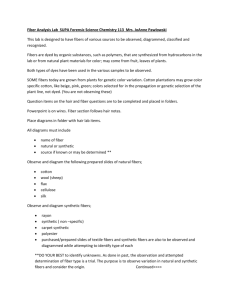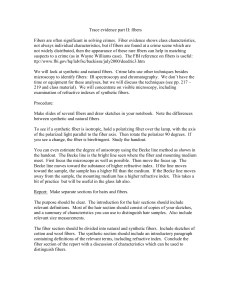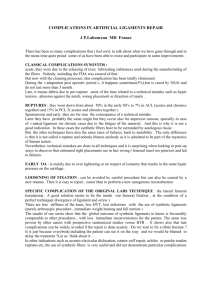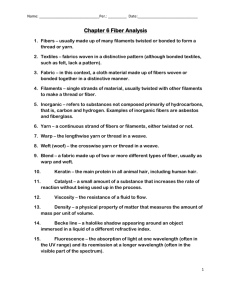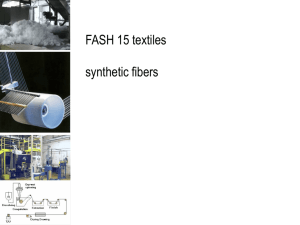FCS 4.7 Synthetic and Natural Fibers
advertisement
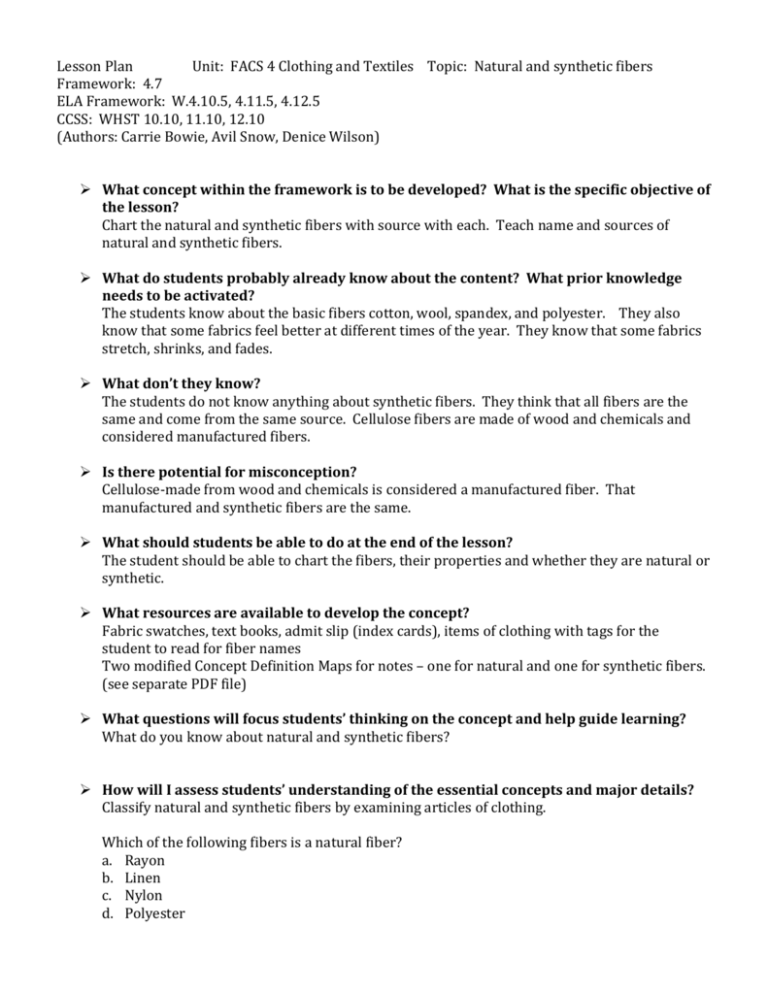
Lesson Plan Unit: FACS 4 Clothing and Textiles Topic: Natural and synthetic fibers Framework: 4.7 ELA Framework: W.4.10.5, 4.11.5, 4.12.5 CCSS: WHST 10.10, 11.10, 12.10 (Authors: Carrie Bowie, Avil Snow, Denice Wilson) What concept within the framework is to be developed? What is the specific objective of the lesson? Chart the natural and synthetic fibers with source with each. Teach name and sources of natural and synthetic fibers. What do students probably already know about the content? What prior knowledge needs to be activated? The students know about the basic fibers cotton, wool, spandex, and polyester. They also know that some fabrics feel better at different times of the year. They know that some fabrics stretch, shrinks, and fades. What don’t they know? The students do not know anything about synthetic fibers. They think that all fibers are the same and come from the same source. Cellulose fibers are made of wood and chemicals and considered manufactured fibers. Is there potential for misconception? Cellulose-made from wood and chemicals is considered a manufactured fiber. That manufactured and synthetic fibers are the same. What should students be able to do at the end of the lesson? The student should be able to chart the fibers, their properties and whether they are natural or synthetic. What resources are available to develop the concept? Fabric swatches, text books, admit slip (index cards), items of clothing with tags for the student to read for fiber names Two modified Concept Definition Maps for notes – one for natural and one for synthetic fibers. (see separate PDF file) What questions will focus students’ thinking on the concept and help guide learning? What do you know about natural and synthetic fibers? How will I assess students’ understanding of the essential concepts and major details? Classify natural and synthetic fibers by examining articles of clothing. Which of the following fibers is a natural fiber? a. Rayon b. Linen c. Nylon d. Polyester Description of Lesson Part of Lesson Strategy Before Admit slip During Concept Definition Map After Exit slip What Students Will Do What Teacher Will Do They will write about what they know about natural and synthetic fibers. Write on the board “What you do you know about natural and synthetic fibers?” Hand the students an index cards for them to write on. Take the cards up, read, and discuss several answers from the students. Student will take notes on the Concept Definition Map sheet Lecture and/or power points to give the notes for the sheets. One sheet will have natural and the other will have synthetic. The students will look at a clothing item and read the tag and decide if it is natural or synthetic. The teacher will have an item of clothing for the students to evaluate. Admit Slips (before) Purpose: To help students connect or use important information from recent lessons or summarize information. Using the Strategy: 1. Write the prompt or task on the board. 2. Set aside 5 minutes at the start of class for students to complete the admit slip, essentially using the admit slip as a bell-ringer. Walk around to read as students write in order to lead the upcoming discussion. 3. Conduct a short class discussion/sharing of ideas from the slip to begin class. 4. Collect the slips. Concept/Definition Map (during) Purpose: To help students develop a full understanding of essential concepts and key terms. Using the Strategy: 1. Identify one or two major concepts or terms for a unit of study. 2. After a lesson that involves exploring the concept or term, introduce the concept definition map. Engage in a class discussion to help fill out cells in the graphic organizer. It is not necessary to achieve a full chart or a complete definition during the first lesson. 3. Revisit the concept definition map two or three times during the unit of study to give students opportunities to develop a more complete description and definition of the term or concept. 4. Use the “What is it?” box last and put the class-generated definition in it. Exit Slips (after) Purpose: To help students connect learning and summarize information. Using the Strategy: 1. Reserve 2-3 minutes at the end of class for students to write their exit slips. Provide note cards or half sheets of paper if appropriate. 2. Assign a sentence stem or question to which they should respond. For example, if you have taught them to summarize, you can ask for a summary of the lesson. You can pose a stem such as “One thing I learned about ___ is…” 3. Collect the exit slips as students leave class. Read through the cards to get a view of what students understand. You may wish to select a few cards with which to begin class the next day. You may want to select cards that typify the responses, offer a unique perspective, or ask a good question. You may wish to share the cards without identifying student names.
